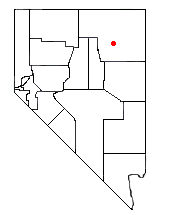
Ruby Mountains
The Ruby Mountains comprise one of the many mountain ranges of the Great Basin in the western United States. They are the predominant range in Elko County, in the northeastern section of the state of Nevada. To the north is Secret Pass and the East Humboldt Range, and the Rubies continue south-southwest for about 80 miles. The highest peak is Ruby Dome (11,387 ft, 3470 m), located at 40°37.3'N and 115°28.5'W in the central core of the range, about 21 miles southeast of the city of Elko Nevada.
The Rubies were named after the garnets found by early explorers. The central core of the range shows extensive evidence of glaciation during recent ice ages, including U-shaped canyons, moraines, hanging valleys, and steeply carved granite mountains, cliffs, and cirques. All of these features can be seen from the 12-mile paved National Scenic Byway up Lamoille Canyon (known as Nevada's Yosemite Valley), which enters the range near the town of Lamoille.
Major valleys include Lamoille Canyon and it's tributaries Thomas and Right Fork Canyons, Seitz, Echo, Box, and Kleckner Canyons. Canyons to the north drain into the Humboldt River, while a group of canyons above the Te-Moak tribal lands constitute the headwaters of the South Fork of the Humboldt River. Major summits include Ruby Dome, Ruby Pyramid, Seitz Peak, Thomas Peak, Liberty Peak, Fitzgerald Peak, Verdi Peaks, Mt. Silliman, and Mt. Gilbert. Prominent peaks further south are Wines Peak, King Peak, and Pearl Peak. To the north are Old-Man-of-the-Mountain and Soldier Peaks.
The glaciers often gouged out basins that are now alpine lakes. The larger of these include Echo, Liberty, Favre, Lamoille, Griswold, and Verdi Lakes, while smaller tarns include the scenic Island, Dollar, Snow, Box, Seitz, Cold, Hidden, and Castle Lakes. Further to the south are North Furlong and Overland Lakes. Water collected by the southern section of the Rubies seeps into the adjacent Ruby Valley to form the Ruby Lake National Wildlife Refuge.
The higher altitude sections of the Ruby Mountains were designated as a 90,000 acre (364 km²) wilderness area in 1989. The isolated Seitz and Echo Canyons are further preserved as an ecologically special Research Natural Area. The Ruby Crest National Recreation Trail winds from Harrison Pass northward about 40 miles to the Road's End Trailhead high in Lamoille Canyon. Principal recreational access can be found at Lamoille and Soldier Canyons on the west side of the range, and at the Overland Lake Trailhead to the east.
The moisture collected by this high range helps support a wide variety of flora and fauna. Lower elevations are covered by aspen trees, while higher up the whitebark pines predominate. Mountain goats, bighorn sheep, mule deer, mountain lions and pikas are common residents. A population of Himalayan Snowcocks was introduced from Pakistan, and is thriving among the high cliffs.